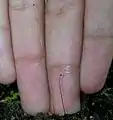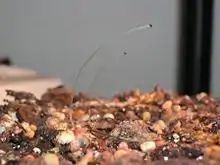Phycomyces
Phycomyces is a genus of fungus in the Zygomycota phylum. They are known for their strong phototropism response and helical growth of the sporangium. The best studied species is Phycomyces blakesleeanus.
| Phycomyces | |
|---|---|
 | |
| Closeup of the Phycomyces sporangium | |
| Scientific classification | |
| Domain: | Eukaryota |
| Kingdom: | Fungi |
| Division: | Mucoromycota |
| Order: | Mucorales |
| Family: | Phycomycetaceae |
| Genus: | Phycomyces Kunze |
| Species | |
| |
Asexual reproduction
Phycomyces can reproduce via extension of mycelia, or by production of spores either asexually or sexually. The asexual cycle includes the formation of spore containing sporangia borne on the top of sporangiophores that may extend 10 to 15 cm above the surface of the fungal colony from which they emerged. The long filamentous sporangiophores respond to divergent environmental signals including light, gravity, wind, chemicals and adjacent objects. The sporangia contain vegetative spores with one to six haploid nuclei. These spores when dispersed can establish new colonies.
Sexual reproduction
Phycomyces have two mating types that are indistinguishable morphologically. The sexual cycle is thought to occur by the following steps. Two hyphae of different mating type encounter each other, and their tips undergo a septation event to produce gametangia. Gametangia are haploid multinuclear cells equivalent to gametes. The two gametangia fuse to form an immature zygospore. Initially the developing zygospore contains thousands of nuclei contributed by the gametangia. During the course of zygospore maturation and dormancy, lasting several months, most nuclei are degraded. It is thought that ordinarily two surviving nuclei, one from each parent, fuse to form a diploid cell which then undergoes meiosis to form haploid meiotic products.[1][2] These then reproduce by mitotic divisions leading to the formation of a sporangium structure (germosporangium) that develops out from the zygospore. The germosporangium contains spores (germspores) that have one to six haploid nuclei like those in the vegetative sporangium.
 Phycomyces sporangium with fingers for size comparison.
Phycomyces sporangium with fingers for size comparison. Phycomyces exhibiting strong phototropism.
Phycomyces exhibiting strong phototropism. newly emerged Phycomyces from a fish food pellet in potting soil.
newly emerged Phycomyces from a fish food pellet in potting soil.
References
- Eslava AP, Alvarez MI, Delbrück M (October 1975). "Meiosis in Phycomyces". Proc. Natl. Acad. Sci. U.S.A. 72 (10): 4076–80. Bibcode:1975PNAS...72.4076E. doi:10.1073/pnas.72.10.4076. PMC 433141. PMID 1060090.
- Eslava AP, Alvarez MI, Burke PV, Delbrück M (July 1975). "Genetic recombination in sexual crosses of phycomyces". Genetics. 80 (3): 445–62. doi:10.1093/genetics/80.3.445. PMC 1213351. PMID 17248685.
External links